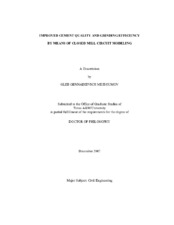| dc.contributor.advisor | Zollinger, Dan | |
| dc.creator | Mejeoumov, Gleb Gennadievich | |
| dc.date.accessioned | 2010-01-15T00:12:31Z | |
| dc.date.accessioned | 2010-01-16T00:35:44Z | |
| dc.date.available | 2010-01-15T00:12:31Z | |
| dc.date.available | 2010-01-16T00:35:44Z | |
| dc.date.created | 2007-12 | |
| dc.date.issued | 2009-05-15 | |
| dc.identifier.uri | https://hdl.handle.net/1969.1/ETD-TAMU-2478 | |
| dc.description.abstract | Grinding of clinker is the last and most energy-consuming stage of the cement
manufacturing process, drawing on average 40% of the total energy required to produce
one ton of cement. During this stage, the clinker particles are substantially reduced in
size to generate a certain level of fineness as it has a direct influence on such
performance characteristics of the final product as rate of hydration, water demand,
strength development, and other. The grinding objectives tying together the energy and
fineness requirements were formulated based on a review of the state of the art of clinker
grinding and numerical simulation employing the Markov chain theory.
The literature survey revealed that not only the specific surface of the final
product, but also the shape of its particle size distribution (PSD) is responsible for the
cement performance characteristics. While it is feasible to engineer the desired PSD in
the laboratory, the process-specific recommendations on how to generate the desired
PSD in the industrial mill are not available.
Based on a population balance principle and stochastic representation of the
particle movement within the grinding system, the Markov chain model for the circuit
consisting of a tube ball mill and a high efficiency separator was introduced through the
matrices of grinding and classification. The grinding matrix was calculated using the
selection and breakage functions, whereas the classification matrix was defined from the
Tromp curve of the separator. The results of field experiments carried out at a pilot
cement plant were used to identify the model's parameters. The retrospective process data pertaining to the operation of the pilot grinding circuit was employed to validate the
model and define the process constraints.
Through numerical simulation, the relationships between the controlled (fresh
feed rate; separator cut size) and observed (fineness characteristics of cement;
production rate; specific energy consumption) parameters of the circuit were defined.
The analysis of the simulation results allowed formulation of the process control
procedures with the objectives of decreasing the specific energy consumption of the mill,
maintaining the targeted specific surface area of the final product, and governing the
shape of its PSD. | en |
| dc.format.medium | electronic | en |
| dc.format.mimetype | application/pdf | |
| dc.language.iso | en_US | |
| dc.subject | Closed Mill Circuit Modeling | en |
| dc.subject | Grinding Efficiency | en |
| dc.subject | Markov Chain Model | en |
| dc.subject | Cement Particle Size Distribution | en |
| dc.subject | Clinker Grindability | en |
| dc.title | Improved cement quality and grinding efficiency by means of closed mill circuit modeling | en |
| dc.type | Book | en |
| dc.type | Thesis | en |
| thesis.degree.department | Civil Engineering | en |
| thesis.degree.discipline | Civil Engineering | en |
| thesis.degree.grantor | Texas A&M University | en |
| thesis.degree.name | Doctor of Philosophy | en |
| thesis.degree.level | Doctoral | en |
| dc.contributor.committeeMember | Butenko, Sergiy | |
| dc.contributor.committeeMember | Little, Dallas | |
| dc.contributor.committeeMember | Saylak, Donald | |
| dc.contributor.committeeMember | Zhukov, Vladimir | |
| dc.type.genre | Electronic Dissertation | en |
| dc.type.material | text | en |
| dc.format.digitalOrigin | born digital | en |


